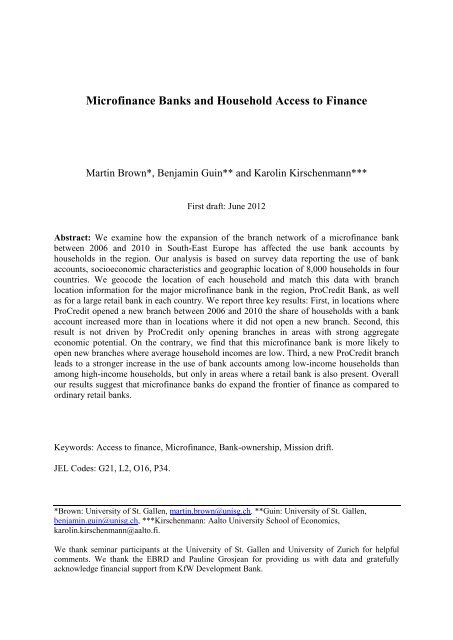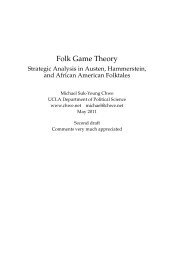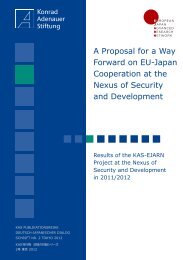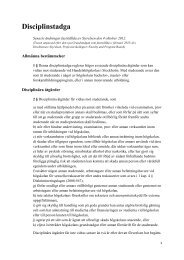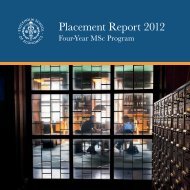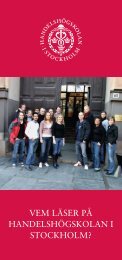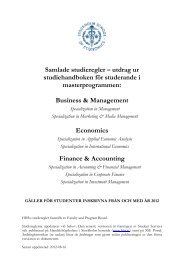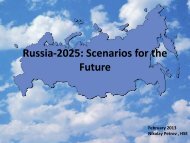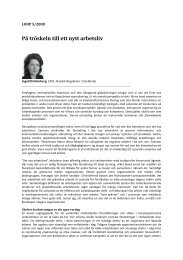Microfinance Banks and Household Access to Finance
Microfinance Banks and Household Access to Finance
Microfinance Banks and Household Access to Finance
- No tags were found...
You also want an ePaper? Increase the reach of your titles
YUMPU automatically turns print PDFs into web optimized ePapers that Google loves.
<strong>Microfinance</strong> <strong>Banks</strong> <strong>and</strong> <strong>Household</strong> <strong>Access</strong> <strong>to</strong> <strong>Finance</strong>Martin Brown*, Benjamin Guin** <strong>and</strong> Karolin Kirschenmann***First draft: June 2012Abstract: We examine how the expansion of the branch network of a microfinance bankbetween 2006 <strong>and</strong> 2010 in South-East Europe has affected the use bank accounts byhouseholds in the region. Our analysis is based on survey data reporting the use of bankaccounts, socioeconomic characteristics <strong>and</strong> geographic location of 8,000 households in fourcountries. We geocode the location of each household <strong>and</strong> match this data with branchlocation information for the major microfinance bank in the region, ProCredit Bank, as wellas for a large retail bank in each country. We report three key results: First, in locations whereProCredit opened a new branch between 2006 <strong>and</strong> 2010 the share of households with a bankaccount increased more than in locations where it did not open a new branch. Second, thisresult is not driven by ProCredit only opening branches in areas with strong aggregateeconomic potential. On the contrary, we find that this microfinance bank is more likely <strong>to</strong>open new branches where average household incomes are low. Third, a new ProCredit branchleads <strong>to</strong> a stronger increase in the use of bank accounts among low-income households thanamong high-income households, but only in areas where a retail bank is also present. Overallour results suggest that microfinance banks do exp<strong>and</strong> the frontier of finance as compared <strong>to</strong>ordinary retail banks.Keywords: <strong>Access</strong> <strong>to</strong> finance, <strong>Microfinance</strong>, Bank-ownership, Mission drift.JEL Codes: G21, L2, O16, P34.*Brown: University of St. Gallen, martin.brown@unisg.ch. **Guin: University of St. Gallen,benjamin.guin@unisg.ch, ***Kirschenmann: Aal<strong>to</strong> University School of Economics,karolin.kirschenmann@aal<strong>to</strong>.fi.We thank seminar participants at the University of St. Gallen <strong>and</strong> University of Zurich for helpfulcomments. We thank the EBRD <strong>and</strong> Pauline Grosjean for providing us with data <strong>and</strong> gratefullyacknowledge financial support from KfW Development Bank.
1. IntroductionOver the past 15 years the microfinance industry has become increasingly formalized <strong>and</strong>commercialized. The provision of financial services <strong>to</strong> the poor by deposit-taking, for-profitmicrofinance banks rather than non-profit, donor-funded NGO’s is seen as a crucial step<strong>to</strong>wards exp<strong>and</strong>ing access <strong>to</strong> finance. Poor households require financial services <strong>to</strong> alignincome <strong>and</strong> expenditure patterns <strong>and</strong> <strong>to</strong> insure themselves against income <strong>and</strong> expenditureshocks. It is therefore crucial that microfinance institutions have the ability <strong>to</strong> provide savingsservices rather than just credit. Moreover, commercial microfinance banks arguably havestronger incentives <strong>to</strong> scale up the provision of financial services <strong>to</strong> the poor than not-forprofitinstitutions.International donors <strong>and</strong> development banks continue <strong>to</strong> support microfinance banksthrough subsidized credit lines <strong>and</strong> equity participation. This support is rationalized by theconjecture that microfinance banks generate positive externalities by offering financialservices <strong>to</strong> households which would not be served by “ordinary” retail banks. Whethercommercial microfinance providers do actually exp<strong>and</strong> the frontier of finance has, however,been questioned by practitioners <strong>and</strong> academics (e.g. Christen, 2001). Indeed, cross-countryevidence by Cull et al. (2007) suggests that there is a trade-off between the scale <strong>and</strong> financialperformance of microfinance providers <strong>and</strong> their outreach <strong>to</strong> poor households <strong>and</strong> femaleentrepreneurs.In this paper we examine <strong>to</strong> what extent microfinance banks exp<strong>and</strong> the frontier ofhousehold finance in South-East Europe. We focus our analysis on four countries in which themajor microfinance bank in the region - ProCredit Bank - has a branch network: Albania,Bulgaria, Macedonia <strong>and</strong> Serbia. Our main data source is the EBRD Life in Transition Survey(LITS). This survey provides information on the use of bank accounts, socioeconomiccharacteristics <strong>and</strong> geographic location of 8,000 households in our four countries in 2006 <strong>and</strong>1
stronger increase in the use of bank accounts among low-income households than amonghigh-income households. In areas where a retail bank is not present this composition effect isreversed: we find a stronger increase in the use of bank accounts among high-incomehouseholds than among low-income households. The intuition behind this surprising result isthat when a retail bank is present high-income households already have a bank account withthe retail bank. Thus an increase in the use of accounts occurs only for low-incomehouseholds. By contrast when a retail bank is not present both high-income <strong>and</strong> low-incomehouseholds open accounts with the microfinance bank.Emerging Europe is an ideal region <strong>to</strong> study the impact of commercial microfinance bankson household access <strong>to</strong> finance. First, despite substantial economic growth over the lastdecade the use of financial services is still low in the region. In the four countries covered byour analysis bank account use varied between 18% <strong>and</strong> 55% of households in 2006. Bycomparison similar survey data shows that in Western Europe more than 95% of allhouseholds hold bank accounts (Beck & Brown 2011). Second, between 2006 <strong>and</strong> 2010 thenumber of bank branches <strong>and</strong> the share of households with bank accounts increasedsubstantially in all four countries. This allows us <strong>to</strong> examine whether the increase in the use ofbank services over time is related <strong>to</strong> the expansion of microfinance bank branches. Third, inthis region we find the presence of an internationally renowned commercial microfinancebank (ProCredit Bank) as well as ordinary retail banks with large branch networks. Thisallows us <strong>to</strong> examine how the proximity <strong>to</strong> a microfinance bank affects access <strong>to</strong> finance,controlling for the presence of retail banks. Fourth, Emerging Europe has seen considerableforeign direct investment in the retail banking sec<strong>to</strong>r over the past decade (see e.g. Claeys <strong>and</strong>Hainz, 2007). Today, international banking groups (e.g. Raiffeisen International, UniCredit,Intesa San Paolo) maintain retail bank networks throughout the region. This raises thequestion whether public investment in the banking sec<strong>to</strong>r, e.g. by supporting microfinancebanks, is necessary in these markets. If the retail networks of international banking groups3
provide similar banking services as microfinance banks, then public support of the latter ishardly warranted.This paper contributes <strong>to</strong> the growing literature on household access <strong>to</strong> formal bankingservices in developing <strong>and</strong> emerging economies. Examining cross-country aggregate data onbranch penetration <strong>and</strong> number of bank accounts Beck et al. (2007) find that government <strong>and</strong>foreign ownership of banks is negatively associated with access <strong>to</strong> finance. Examining crosscountryinformation on product terms of large banks Beck et al. (2008) find that barriers forbank cus<strong>to</strong>mers are higher where banking systems are predominantly government-owned <strong>and</strong>lower where there is more foreign bank participation. Beck <strong>and</strong> Brown (2011) provideevidence on the relation between household characteristics, bank-ownership <strong>and</strong> householduse of banking services for 28 transition economies. Their analysis (also based on the LITSdata) suggests that foreign banks cherry pick their clients: high-income <strong>and</strong> well-educatedhouseholds are more likely <strong>to</strong> have bank accounts in countries where foreign banks havehigher market shares. Recent household surveys have also allowed researchers <strong>to</strong> examine therelation between household characteristics <strong>and</strong> the use of formal <strong>and</strong> informal financialservices in Sub-Saharan Africa (see for example, Honohan <strong>and</strong> King, 2009; Beck et al., 2010;Atiero et al., 2011). 1 We complement the above literature by documenting how the proximity<strong>to</strong> microfinance banks as opposed <strong>to</strong> ordinary retail banks affects the use of banking servicesat the household level.We further contribute <strong>to</strong> the ongoing debate on the mission drift of commercialmicrofinance institutions. Examining income-statement <strong>and</strong> loan portfolio data for 124 of thelargest microfinance institutions worldwide for the period 1999-2002 Cull et al. (2007) findevidence for a mission drift in commercialization: Larger <strong>and</strong> more profitable microfinanceinstitutions have higher average loan sizes <strong>and</strong> serve a lower share of female clients. Mersl<strong>and</strong>1 There have been a series of country-level studies on Brazil, Mexico, <strong>and</strong> Romania, among others, over the pastten years. Most of these, however, use a sample that is geographically limited, even within the respectivecountry. For a broader overview <strong>and</strong> discussion, see World Bank (2007).4
<strong>and</strong> Strøm (2010) examine data for 379 microfinance institutions from 74 countries over theperiod 2001-2008. They also find evidence for a mission drift: more profitable institutionsdisplay higher average loan sizes. Their findings suggest, however, that this mission drift maybe contained if commercial microfinance providers become more cost-efficient. Wecontribute <strong>to</strong> the above literature by providing household-level evidence (as opposed <strong>to</strong> banklevelevidence) on how commercial microfinance banks impact on access <strong>to</strong> finance.Moreover, in contrast <strong>to</strong> the existing literature on mission drift we study outreach in terms ofbank account use instead of loan take-up. Providing suitable financial products besides loanshas become an increasingly important aspect of the business of microfinance institutions buthas achieved less attention in the literature so far (World Bank, 2007; Berg, 2010). Finally,rather comparing the outreach of commercial microfinance banks <strong>to</strong> that of non-commercialmicrofinance institutions, we compare their outreach <strong>to</strong> that of ordinary retail banks. In ourview, especially in Emerging Europe where classic microfinance approaches such as groupbasedlending do not play an important role this is the relevant comparison for policy makersdeciding on whether <strong>to</strong> continue supporting commercial microfinance banks.The remainder of this paper is organized as follows. In section 2 we present a model ofhousehold deposit decisions <strong>and</strong> bank location decisions <strong>and</strong> derive hypotheses for ourempirical analysis. Section 3 describes our data. Section 4 presents the methodology <strong>and</strong>empirical results <strong>and</strong> section 5 concludes.2. Model <strong>and</strong> hypothesesIn this section we develop a simple model that illustrates how the presence of amicrofinance bank affects the number <strong>and</strong> type of households which use a bank account <strong>and</strong>how this impact depends on the presence of a retail bank. At the same time our model points<strong>to</strong> potential selection effects, i.e. the decision of a microfinance bank <strong>to</strong> open a branch in alocation will depend both on the characteristics of households in that area <strong>and</strong> the presence of5
a retail bank. Our model is related <strong>to</strong> that of Mulligan <strong>and</strong> Sala-i-Martin (2000) who study theextensive margin of holding bank deposits as opposed <strong>to</strong> cash money. We extend their modelby considering heterogeneous bank types.Model set up<strong>Household</strong>s live in one of L regions in the economy. There are n lhouseholds in eachregion l. Each household i has assetsA i. Each household has <strong>to</strong> decide what share α ∈[0,1]ofassets <strong>to</strong> hold in cash money (M) <strong>and</strong> what share <strong>to</strong> hold in bank deposits (D). Hereby wehaveD= − ⋅ .= α ⋅ Ai<strong>and</strong> M (1 α) AiEach household has <strong>to</strong> execute a volume of real transactions which is assumed <strong>to</strong> be linearin assets Ti = t⋅ Ai. When doing so, households incur transaction costs which areproportionate <strong>to</strong> the share of required funds not held in cash.( ) ( α )[1] C = c ⋅ T − M = c ⋅ T −(1 − ) Ai i i i i i iWe assume that transaction costs per unit c iare heterogeneous across households, forexample due <strong>to</strong> differences in the proximity <strong>to</strong> the regional <strong>to</strong>wn where a bank branch may belocated.<strong>Banks</strong> charge a fixed fee ϕ > 0 for opening an account <strong>and</strong> offer a real interest rate of Rper unit deposited <strong>and</strong>. There are two banks in the economy: a <strong>Microfinance</strong> Bank (MFB) <strong>and</strong>a Retail Bank (RB). The fixed fee of opening an account is assumed <strong>to</strong> be lower at themicrofinance bank ϕMFB< ϕ . This may be related <strong>to</strong> lower monetary costs in terms of feesRBor minimum balance requirements, but also due <strong>to</strong> non-monetary costs, such as morecomplicated procedures or “cultural barriers” between bank staff <strong>and</strong> certain household types.The retail bank offers a higher interest rate per unit deposited R RB> R MFB. We can also think6
of this extra interest in terms of extra benefits of having an account with a retail bank due <strong>to</strong>broader services.In our model decisions of banks <strong>and</strong> households take place in three steps: First, banksdecide simultaneously whether <strong>to</strong> open a branch in a location. Second, households decidewhether <strong>to</strong> open an account at one of the bank branches in their location. Third, householdswith bank accounts decide on the share of their assets <strong>to</strong> deposit in their account. In thefollowing we solve the model by backward induction.<strong>Household</strong> deposit decisionsSuppose a household has opened an account at a bank j. The household then chooses an*optimal share α ∈ [0,1] so as <strong>to</strong> maximize the net benefits from an account at bank j:j[2] R ⋅α⋅A −c ⋅( t⋅A −(1 −α) ⋅A)−ϕj i i i i jThe first term in equation [2] represents the gross benefits from the account, the secondterm represents the incurred transaction costs due <strong>to</strong> not holding cash <strong>and</strong> the third term the<strong>to</strong>tal costs of opening the account. For simplicity we have assumed linearity of costs <strong>and</strong>benefits of depositing money. As a consequence a household will either deposit all assets**( α = 1) if Rj ≥ cior not deposit anything ( α = 0 ) if Rj < ci.We assume that the transaction costs of households are distributed so that some householdshave no transaction costs ( c = 0 ). These are households which live close <strong>to</strong> the economic hubof the region where a bank would be located. The rest of the households have prohibitivelyhigh transaction costs as they live far away from the economic hub of the region. Forreasonable levels of interest rates they will not open an account: c> R1,R2. Given theseassumptions, within any region only households which live close <strong>to</strong> the economic hub willconsider opening an account. <strong>Household</strong>s that do open an account will deposit their entireassets in the account.7
When deciding on whether <strong>to</strong> open a bank account, <strong>and</strong> at which bank <strong>to</strong> do so, householdsweigh the anticipated benefits of opening the account against the fixed cost of opening anaccount. As the household anticipates that it will deposit all assets in the bank account thecondition for earning a positive return from a bank account is given byR ⋅A ≥ ϕ , orj i j[3] Aiϕj≥RjCondition [3] denotes the minimum level of assets required for a household i <strong>to</strong> yield apositive return from opening a bank account at bank j. We assume in the following that thethreshold of assets required <strong>to</strong> benefit from a retail bank account is higher than that required ata microfinance bank:ϕR[4]MFB RBMFBϕ R2,R1,or havevery low asset levels:AiϕRMFB< . Type 2 households only open an account at theMFBmicrofinance bank. These are households which have low transaction costs ci= 0<strong>and</strong> lowϕRB ϕMFBasset levels: > Ai≥ . Type 3 households will open an account at both banks, butR RRBMFBprefer the microfinance bank. These are households which have low transaction costs ci= 0<strong>and</strong> moderate asset levels:Aiϕ≥RRBRBϕ,RMFBMFBA
households which have low transaction costsci=0Ai<strong>and</strong> high asset levelsϕ≥RRBRBϕ,RMFBMFB<strong>and</strong>Ai≥ϕRBMFB( R −R)RB−ϕMFB⋅Location decision of banksThe decision <strong>to</strong> open a branch in a location is determined by the number of potentialclients. We assume for simplicity that each bank type j has fixed costs of running a branch<strong>and</strong> earns a fixed income per client πj. The number of clients required for a branch <strong>to</strong> breakβjeven is thereforeβjπ .jWe assumed above that there are L locations with population sizes of n lin the economy.l l l lThe share of each type of household in each location is defined asδ , δ , δ , δ 1 2 3 4 <strong>and</strong> is knownlwith certainty by all banks. Hereby, ∑ δh= 1 .hGiven that some households would open an account at both banks, the decision of themicrofinance bank <strong>to</strong> locate in an area depends on the location decision of the retail bank (<strong>and</strong>vice-versa). The number of clients served by the microfinance bank if it opens a branch isgiven by:[5]2 3( δl + δl ) nl2 3 4( δ + δ + δ )nl l l lif the retail bank is in the locationif the retail bank is not in the locationThe number of clients served by the retail bank is given by:[6]4( δl) nl3 4( δ + δ )nl l lif the microfinance bank is in the locationif microfinance bank is not in the location9
The profits of the banks depending on their mutual decisions <strong>to</strong> enter a location arepresented in Table 1.Table 1. Profits of banksRetail Banknot enterenter<strong>Microfinance</strong>Banknot enter 0,0enter⎡⎣ + ⎤⎦ −3 40, nl δl δl πRB βRB2 3 4n ⎡l ⎣δ ,0l+ δl + δ ⎤l ⎦πMFB −βMFB 2 3 4n ⎣⎡δ + δ ⎦⎤π −β , n ⎣⎡δ ⎦⎤π −βl l l MFB MFB l l RB RBResults <strong>and</strong> empirical hypothesesAssuming a given income <strong>and</strong> cost structure of each bank type ( π , , , )MFBβMFB πRB βRBwederive the following results from equations [5, 6] <strong>and</strong> Table 1:(i) Branch network: Given the population size of a location n l<strong>and</strong> the presence of a retailbank in the location the microfinance bank is more likely <strong>to</strong> open a branch when the2 3share of low <strong>and</strong> moderate wealth households ( δ + δ ) is higher. If a retail bank has4no branch in that location the share of high-wealth households δlalso influences thedecision of the microfinance bank. A higher share of very-low-income households( δ ) does not increase the propensity of the microfinance bank <strong>to</strong> open a branch as1lthese households do not dem<strong>and</strong> accounts.(ii) Client structure: In any location where the microfinance bank <strong>and</strong> the retail bank have a2 3branch the former will serve low- <strong>and</strong> moderate wealth households ( l,l )4latter serves high-income households ( δl )llδ δ , while the. Comparing locations where only one of10
3. Data <strong>and</strong> Methodology3.1. Life in Transition Survey <strong>and</strong> Bank branch dataOur main data source is the EBRD-World Bank Life in Transition Survey (LITS) whichwas conducted in 29 countries in 2006 <strong>and</strong> 2010 as a repeated cross-sectional survey. In eachcountry, 50 Primary Sampling Units (PSUs) were selected with probability of selectionproportional <strong>to</strong> PSU size. Then twenty households within each PSU were r<strong>and</strong>omly selected,resulting in roughly 1,000 observations per country. 2 The first part of the interviews wasconducted with the household head <strong>and</strong> yields information on household composition,housing, expenses <strong>and</strong> the use of services. For the second part of the survey, a r<strong>and</strong>omlyselected adult household member was interviewed about attitudes <strong>and</strong> values as well as thepersonal work his<strong>to</strong>ry, education <strong>and</strong> entrepreneurial activity. For the purpose of our study,we use information from the first part of the survey <strong>to</strong> obtain indica<strong>to</strong>rs of household use ofbanking services, location, size <strong>and</strong> income as well as the gender <strong>and</strong> age of the householdhead. From the second part of the survey, we obtain indica<strong>to</strong>rs of education, employmentstatus, religion <strong>and</strong> ethnicity.We focus our study on four South-Eastern European countries: Albania, Bulgaria,Macedonia <strong>and</strong> Serbia. For these four countries we augment the LITS survey data withgeographical information on the location of PSUs. We then match the LITS survey data withgeographical information on the branch location of the largest microfinance bank in theregion: ProCredit Bank. We further match our survey data with geographical data on thebranches of a large retail bank in each country. In each country, we choose the largest,2 In the 2010 survey wave, 1,500 households were interviewed in Serbia.12
country-wide retail bank for which bank branch location data is publicly available. 3Appendix 1 provides information on the ProCredit <strong>and</strong> retail banks.We h<strong>and</strong>-collect the 2006 <strong>and</strong> 2010 branch location information for ProCredit bank <strong>and</strong> theretail banks from the bank websites. Then we specify the exact location in terms of thelatitude <strong>and</strong> longitude of each branch <strong>and</strong> PSU using Google maps. Appendix 2 offers acar<strong>to</strong>graphical overview of the locations of PSUs, ProCredit branches <strong>and</strong> retail bankbranches by country in 2006 <strong>and</strong> 2010.[Insert Table 2 here]Table 2 provides the definitions <strong>and</strong> sources of all variables used in our analysis. We dropall observations with missing income information so that our final sample consists of 3,992observations in 2006 <strong>and</strong> 4,266 observations in 2010. The dependent variable in all ourempirical analyses is Account which indicates whether any member of the household has abank account. Table 3 shows that in each of the four countries the average use of bankaccounts increased strongly between 2006 <strong>and</strong> 2010. The increase is largest in Macedonia <strong>and</strong>Albania where the share of households with account rose by 38 <strong>and</strong> 26 percentage pointsrespectively. The increase in Bulgaria (12 percentage points) <strong>and</strong> Serbia (14 percentagepoints) is also substantial.[Insert Table 3 here]Table 3 shows that the surge in bank accounts in the region coincides with the expansionof the branch networks of both ProCredit as well as the retail banks. The number of ProCredit3 In Albania <strong>and</strong> Serbia the chosen retail banks are those with the largest branch network in the respectivecountry. In Macedonia we take the largest bank in terms of assets because the availability of online branchlocation information is best for this bank. Only in Bulgaria we have <strong>to</strong> resort <strong>to</strong> the fourth largest bank in termsof assets because all three larger banks do not provide his<strong>to</strong>rical branch location information for 2006 online.13
anches in our sample increased from 111 in 2006 <strong>to</strong> 254 in 2010, while the number of retailbank branches increased from 352 <strong>to</strong> 653. As a consequence of this branch expansion theaverage travel distance 4 in kilometers between ProCredit branches <strong>and</strong> surveyed householdswas reduced from 21.6 km <strong>to</strong> 10.5 km. By comparison, the average distance between retailbank branches <strong>and</strong> surveyed households was reduced from 10.5 km <strong>to</strong> 7.2 km. Overall, thelarger number of bank branches <strong>and</strong> the shorter travel distances <strong>to</strong> households indicate that theretail banks chosen for our analysis have a more comprehensive coverage in the region thanProCredit bank.We measure the proximity between households <strong>and</strong> bank branches with the dummyvariables ProCredit close <strong>and</strong> Retail Bank close. These indica<strong>to</strong>rs are one if the nearestProCredit or retail bank branch, respectively, is within a travel distance of five kilometers ofthe PSU where a household is located, <strong>and</strong> zero otherwise. As robustness tests, we employdifferent travel distance cut-offs (10km, 20km). We use distance thresholds as opposed <strong>to</strong>continuous measures of travel distance in order <strong>to</strong> capture the idea that the transaction costs ofusing a bank account depend on whether a household is within walking, cycling or localpublic transport distance of a bank branch or not.[Insert Table 4 here]We relate the use of bank accounts not only <strong>to</strong> the proximity <strong>to</strong> microfinance <strong>and</strong> retailbank branches but also <strong>to</strong> the economic environment <strong>and</strong> socioeconomic characteristics ofhouseholds. Table 4 reports summary statistics for these variables. We expect the use ofaccounts <strong>to</strong> be related <strong>to</strong> the economic activity in the location of households since households.As the economic activity is arguably higher in more urban than rural areas, Town closeindicates whether the nearest city with more than 10,000 inhabitants is within a travel distance4 Travel distance, in contrast <strong>to</strong> linear distance, is the road distance between two locations as obtained fromGoogle maps.14
of five kilometers. Both in 2006 <strong>and</strong> in 2010, about half of our sample households live close<strong>to</strong> a <strong>to</strong>wn.In our model, we examine how microfinance banks differ in their propensity <strong>to</strong> serve lowwealthhouseholds as compared <strong>to</strong> ordinary retail banks. As an indica<strong>to</strong>r of household wealthwe employ a measure of current household income. We measure household income (in logUSD) with households’ annual consumption expenses according <strong>to</strong> the OECD householdequivalized scale. The variable Low income then is a dummy variable which is one if thehousehold income is below the 2006 median income in its country of location, <strong>and</strong> zerootherwise.As microfinance banks also aim <strong>to</strong> serve households that rely on informal entrepreneurialactivity or agricultural income we examine the relative propensity of ProCredit <strong>to</strong> bank thesesuch households. The income source of a household is captured by the dummy variableInformal income which takes on the value of one if the respondent had no formal laborcontract within the previous twelve months, <strong>and</strong> zero otherwise. In our sample 72% ofhouseholds observed in 2006 rely on informal income sources, while this is the case for 66%of households observed in 2010.We employ household-level covariates <strong>to</strong> control for variation in household dem<strong>and</strong> forfinancial services <strong>and</strong> transaction costs in using these services. University degree indicateswhether the respondent <strong>to</strong> the survey has a tertiary-level degree <strong>and</strong> thus might be moreknowledgeable about financial matters. We further control for <strong>Household</strong> size, which is thenumber of adults <strong>and</strong> children living in a household, as well as the Age (measured in logyears) of the household head. The dummy variable Female captures the gender of thehousehold head. Language captures whether the respondent speaks at least one officiallanguage of the respective country <strong>and</strong> is thus a measure of social integration. Finally, Muslimis a dummy variable indicating whether the respondent is a follower of Islam <strong>and</strong> might be15
eluctant <strong>to</strong> use commercial banking services for religious reasons. 5 We control for ownershipof a Car, which may obviously affect transaction costs of using a bank account, but which isalso a proxy for household wealth. Finally, we control for household use of technical devices,i.e. Computer, Mobile phone <strong>and</strong> Internet connection as these may reduce the transactioncosts of having a bank account (e.g. through mobile banking or e-banking). At the same timehousehold use of these devices may mirror the economic activity or wealth of the household.Summary statistics for our main explana<strong>to</strong>ry variables <strong>and</strong> control variables are displayed inTable 4 by survey wave.3.2. Synthetic panel datasetOur identification strategy is based on exploiting the branch expansion of ProCredit bankin the period 2006-2010. The LITS 2006 <strong>and</strong> LITS 2010 surveys provide repeated crosssectiondata, so that we do not observe the same household in 2006 <strong>and</strong> again in 2010. Wetherefore generate a synthetic panel by matching households observed in 2006 with similarhouseholds observed in 2010. Our matching procedure is based on the proximity ofhouseholds <strong>to</strong> branches of ProCredit Bank <strong>and</strong> the retail bank, proximity <strong>to</strong> a <strong>to</strong>wn as well ason the level <strong>and</strong> source of household income. The matching variable ProCredit close in 2006measures whether the household was located within 5km of a ProCredit branch in 2006.Retail Bank close in 2006 measures whether the household was located within 5km of a retailbank branch in 2006. Note that for all households observed in 2010 we match their location in2010 with the bank branch networks in 2006. We thus assume that households have notmoved location between 2006 <strong>and</strong> 2010. Town close measures whether the household islocated within 5km of a <strong>to</strong>wn of 10,000 or more inhabitants. <strong>Household</strong>s are matched onincome level <strong>and</strong> income source with the variables Low income <strong>and</strong> Informal income. In order<strong>to</strong> make household income levels comparable across survey waves for households observed in5 Using the LITS 2006 data Grosjean (2011) provides evidence that regions in South-East Europe which wereunder the influence of the Ot<strong>to</strong>man Empire show a lower level of financial development.16
2010 Low income measures whether the household’s income is below the 2006 countrymedian.We perform a one-<strong>to</strong>-one match, i.e. each household in the 2006 LITS survey is matched<strong>to</strong> one household covered by the LITS 2010 survey. LITS 2006 households that cannot bematched <strong>to</strong> a LITS 2010 household are dropped. Likewise, LITS 2010 households that cannotbe matched <strong>to</strong> a LITS 2006 household are also dropped. In addition, we drop all observationsthat have missing values for at least one of the dependent or independent variables. As shownin Table 5 Panel A, our matching process generates a <strong>to</strong>tal sample of 2,613 potentialhousehold pairs for our synthetic 2006-2010 panel.[Insert Table 5 here]To identify the impact of new ProCredit bank branches opened between 2006 <strong>and</strong> 2010,we drop 1,009 household pairs which were already close <strong>to</strong> ProCredit bank branches in 2006.We further consider only household pairs for which the closeness <strong>to</strong> a retail bank branch doesnot change between 2006 <strong>and</strong> 2010. We thus drop 110 household pairs for which closeness <strong>to</strong>a branch of the retail bank changed in our observation period. This leaves us with a <strong>to</strong>talsynthetic panel of 1,494household pairs in two sub-samples: 477 pairs which are alreadywithin a 5km radius of a retail bank branch in 2006 as well as 1,017 household pairs whichare not within a 5km radius of a retail bank branch in 2006 <strong>and</strong> 2010. Table 5, Panel Bprovides details of the characteristics of our final synthetic panel dataset.4. ResultsAs outlined in section 2 we test three hypotheses in our empirical analysis: Do morehouseholds have a bank account in regions where ProCredit Bank has opened a branchcompared <strong>to</strong> locations where it has not opened a branch (volume effect). Is ProCredit Bank17
more likely <strong>to</strong> open new branches in regions with a higher share of low-income or informalincomehouseholds (location effect)? Does proximity <strong>to</strong> a ProCredit Bank branch increase theuse of bank accounts more for low-income <strong>and</strong> informal-income households than it does forhigh-income <strong>and</strong> formal-income households (composition effect)? We present our results forthe volume effect <strong>and</strong> location effect in section 4.1 followed by results for the compositioneffect in section 4.2.4.1. Volume <strong>and</strong> location effectTable 6 presents univariate results for the volume effect based on a difference-indifferenceanalysis. For each household pair in our synthetic panel we calculate the change inthe use of a bank account between 2006 <strong>and</strong> 2010. At the pair level this yields a value ofeither 0 (no change), +1 (an account is used in 2010 but not in 2006) or -1 (an account is usedin 2006 but not in 2010). 6 We then compare the average change in account of those pairs forwhich a new ProCredit branch was opened within a radius of 5km <strong>to</strong> those pairs for which anew ProCredit branch was not opened within a radius of 5km. This comparison is conductedseparately for household pairs which are close <strong>to</strong> a retail bank <strong>and</strong> households which are notclose <strong>to</strong> a retail bank.The first row of Table 6 presents results for household pairs which are close <strong>to</strong> a retailbank (in 2006 <strong>and</strong> 2010). For household pairs in regions where ProCredit opened a newbranch we find no increase in the use of bank accounts of 23 percentage points. By contrast,for household pairs in regions where ProCredit did not open a new branch the use of bankaccounts hardly changes at all. The difference-in-difference results suggest that the use ofbank accounts increased by 24 percentage points more in regions where a new ProCreditbranch was opened in addition <strong>to</strong> an existing retail bank branch.6 Of the 1,494 pairs in our synthetic panel 429 pairs take on the value +1, 846 the value 0 <strong>and</strong> 219 the value -1.18
The second row of Table 6 present results for household pairs which are not close <strong>to</strong> aretail bank in 2006 or 2010. The results in this row show that the use of bank accountsincreases by 54 percentage points over time in those locations where ProCredit bank did opena new branch as compared <strong>to</strong> 13 percentage points in regions where no new branch wasopened. The difference-in-difference estimate suggests that the use of bank accountsincreased by 41 percentage points more in areas without a retail bank but where ProCreditBank opened a new branch between 2006 <strong>and</strong> 2010.[Insert Table 6 here]The Table 6 results suggest that the volume effect of microfinance branches is significantlylower in regions where a retail bank branch is present compared <strong>to</strong> regions where the retailbank is not present. This confirms the predictions of our model in section 2. That said, theresults for the subsample where the retail bank is not close have <strong>to</strong> be interpreted with carebecause of the low number of pairs which are located in areas with new ProCredit branches(only 30 observations).In Appendix 3 we test whether the difference-in-difference results displayed in Table 6 arerobust <strong>to</strong> changes in the distance thresholds employed in our matching procedure <strong>and</strong>empirical analysis. The analysis presented above defines “closeness” <strong>to</strong> a ProCredit branch, aretail bank branch, or a <strong>to</strong>wn as lying within a 5km radius of the nearest branch or <strong>to</strong>wn. Inour robustness tests we extend this radius <strong>to</strong> 10km (Panel A) <strong>and</strong> 20km (Panel B). By doingso the number of observations available for our empirical analysis is reduced as ouridentification strategy relies on considering only those households which are not close <strong>to</strong> aProCredit branch in 2006. At the same time, the share of observations in our two subsamples– retail bank “close” <strong>and</strong> retail bank “not close” - shifts <strong>to</strong>wards the former as we extend theproximity radius.19
The results presented in Appendix 3 confirm our findings for the subsample of householdswhich are located close <strong>to</strong> a retail bank. In this subsample, a new ProCredit branch isassociated with an increase in bank account use by 27 percentage points (Panel A – 10 kmradius) <strong>and</strong> 32 percentage points (Panel B – 20 km radius), respectively. As a result of theabove mentioned changes in sample composition we can no longer estimate reliabledifference-in-difference effects for the subsample of households which are not close <strong>to</strong> a retailbank. The reason is that in Panel A we observe only 10 household pairs which are not close <strong>to</strong>a retail bank <strong>and</strong> where ProCredit opens a new branch between 2006 <strong>and</strong> 2010. In Panel B weobserve 9 such households.The univariate results displayed in Table 6 are confirmed by the multivariate analysispresented in Table 7. Here we report the outcome of first-difference GLS regressions relatingthe change in account use (D.Account) within each household pair over time <strong>to</strong> the change inProCredit being within a five kilometer travel distance (D.ProCredit close). The regressiondoes not include the covariates Town close, Low income or Informal income as householdspairs are matched on these characteristics. We control for differences in all socioeconomiccharacteristics within household pairs that are not used in the matching procedure <strong>and</strong> thusmay vary across observation periods. St<strong>and</strong>ard errors are reported in brackets <strong>and</strong> areclustered at the matched household pair-level.Column (1) of Table 7 provides estimates for the subsample of household pairs which areclose <strong>to</strong> the retail bank, while column (2) provides estimates for households which are notclose <strong>to</strong> the retail bank. We find that for households that are close <strong>to</strong> a retail bank the use ofaccounts increases by 26 percentage points when ProCredit opens a new branch within thefive kilometer travel distance radius between 2006 <strong>and</strong> 2010. For households which are notclose <strong>to</strong> a retail bank the effect from a new ProCredit branch is an increase in the use bankaccounts by 38 percentage points. Thus in line with our univariate results these multivariateresults suggest a significant volume effect of new ProCredit bank branches. Moreover, our20
multivariate results confirm that the volume effect is substantially weaker in regions where aretail bank is present.[Insert Table 7 here]The analysis presented in Table 6 <strong>and</strong> 7 does not take in<strong>to</strong> account that the decision ofbanks <strong>to</strong> open new branches is endogenous. The positive correlation observed between newProCredit branches <strong>and</strong> the increase in use of bank account presented in our univariate <strong>and</strong>multivariate analysis may thus be biased estimates of the actual volume effect of microfinancebanks. Our empirical concern is that ProCredit Bank may have opened branches in thoseregions which experienced a strong aggregate increase in economic activity <strong>and</strong> use of retailbank accounts <strong>and</strong> thus that the observed correlation in Tables 6 <strong>and</strong> 7 may be due <strong>to</strong> reversecausality.Note that positive correlation between the aggregate economic potential of a region <strong>and</strong> theopening of a microfinance bank branch is only partly in line with the location effect predictedin section 2. There we showed that conditional on the presence of a retail bank themicrofinance bank should be more likely <strong>to</strong> open a branch in locations with a large share oflow-income <strong>and</strong> moderate-income households. Thus an improvement in economic conditionsin a region should only spur an expansion of the ProCredit branch network if thisimprovement takes place at the bot<strong>to</strong>m end of the income ladder. ProCredit should beparticularly interested in opening new branches where there are many households with verylow, but increasing income levels. By contrast in regions where income improvements areconcentrated among high-income households the microfinance bank should be less likely <strong>to</strong>open new branches as these households would be served by ordinary retail banks.To examine the location effect of microfinance banks <strong>and</strong> <strong>to</strong> yield unbiased estimates oftheir volume effect we employ a two-stage instrumental variable analysis. In the first stage we21
estimate the location decision of ProCredit Bank. The dependent variable is thus D.ProCreditclose. In the second stage of our IV analysis we examine the volume effect by regressing ourindica<strong>to</strong>r of the change in bank account use (D.Account) on the predicted values ofD.ProCredit close derived from the first stage <strong>and</strong> individual household characteristics. 7As instruments in the first stage we use the 2010 PSU averages of Low Income, Informal,Female, Muslim as well as the variable Town close as indica<strong>to</strong>rs of the potential dem<strong>and</strong> forbank accounts in a region. The averages are calculated for each individual household as theaverage of the respective variable across all other households in the same PSU. The economicrationale behind these instruments follows from our model which suggests that the averagesocioeconomic conditions in a PSU should affect the location decision of the microfinancebank. As we use average PSU indica<strong>to</strong>rs for 2010 we account for the expected futureeconomic conditions in a region which should drive the banks location decision between 2006<strong>and</strong> 2010. At the same time we assume that the average socioeconomic structure of otherhouseholds in a region only indirectly affect the propensity of an individual household in thatPSU <strong>to</strong> open a bank account via their impact on ProCredit’s location decision.[Insert Table 8 here]Table 8 reports results of our IV estimation which we conduct separately for our twosubsamples of household-pairs: those pairs which are close <strong>to</strong> a retail bank (columns 1-2) <strong>and</strong>those which are not close <strong>to</strong> a retail bank (columns 3-4). The first-stage results reported incolumn (1) provide mixed support for a location effect. Considering only those locationswhich are close <strong>to</strong> a retail bank we find that ProCredit is more likely <strong>to</strong> open a new branch in7 We resort <strong>to</strong> estimating linear probability models because interpreting marginal effects of interaction terms innon-linear regressions is less straightforward (see Ai <strong>and</strong> Nor<strong>to</strong>n, 2003). Besides, the linear probability modelshould be a fairly good approximation as our interest primarily lies in the effects around the means of thedistributions of our main explana<strong>to</strong>ry variables (see Table 4 which shows that our distance cut-off of fivekilometres is relatively close <strong>to</strong> the mean of the continuous distance variables).22
areas with more Low-income households. The estimated coefficient is statistically significant,<strong>and</strong> relevant from an economic viewpoint: A rise in the share of low income households by 10percentage points would increase the probability of ProCredit opening a new branch by 5%.By contrast, the estimated coefficient for Avg. Informal income is not significant at anyconventional level, suggesting that ProCredit is not more likely <strong>to</strong> open new branches in areaswith more informal economic activity.Diagnostic statistics provided for the column (1-2) estimates suggest that our instrumentsare strong in the subsample of regions where a retail bank is close. The F-test shows that theinstrumental variables are jointly different from zero. Additionally, the significantKleibergen-Paap statistic indicates that the model is adequately identified. The Hansen’s Jstatistic is not significant at conventional levels suggesting that our instruments are valid inthis specification.The second-stage results displayed in column (2) show that controlling explicitly forProCredit’s location decision we still find a significant <strong>and</strong> positive volume effect of newProCredit branches in this subsample. The estimated coefficient suggests that in regionswhere the retail bank is present the opening of a ProCredit branch within 5 km of a householdincreases the likelihood of that household having a bank account by 49 percentage points.In columns (3-4) we do not find any significant results for the subsample of householdswhich are not close <strong>to</strong> a retail bank. The reason behind this lack of results seems <strong>to</strong> be weakstatistical power in the first-stage regression. Out of the 1,017 household pairs in thissubsample we only observe 26 pairs for which ProCredit opens a new bank branch between2006 <strong>and</strong> 2010. An F-test suggests that our instrumental variables are not at all significant inthe first stage regression.Together the results in Tables 6, 7 <strong>and</strong> 8 provide evidence of a significant volume effectinduced by the expansion of the ProCredit Bank branch network between 2006 <strong>and</strong> 2010. Wealso find evidence for a location effect of this microfinance bank: In those regions where a23
etail bank is already present, ProCredit Bank was more likely <strong>to</strong> open a branch where incomelevels are lower. Together these effects suggest that the expansion of the ProCredit branchnetwork should have led <strong>to</strong> a disproportionate increase in the use of bank accounts amonglow-income households as compared <strong>to</strong> high-income households. We study the extent of thiscomposition effect in the next section.4.2. Composition effectTable 9 presents univariate results for the composition effect based on a difference-indifferenceanalysis. Replicating our analysis in Table 6 we compare the average change inaccount of household pairs for which a new ProCredit branch was opened between 2006 <strong>and</strong>2010 <strong>to</strong> those pairs for which a new ProCredit branch was not opened. We conduct thiscomparison again separately for household pairs which are close <strong>to</strong> a retail bank (Panel A)<strong>and</strong> households which are not close <strong>to</strong> a retail bank (Panel B). Within each panel we nowcompare the impact of new ProCredit branches for low-income <strong>and</strong> informal-incomehouseholds <strong>to</strong> the impact for high-income <strong>and</strong> formal-income households.[Table 9 here]The Table 9, Panel A results confirm that in regions where a retail bank is already presentnew microfinance bank branches are associated with a stronger increase in the use of bankaccounts among low-income households. The reported difference-in-difference estimatessuggest that a new ProCredit branch increases the use of bank accounts among low-incomehouseholds by 35 percentage points while the corresponding effect for high-incomehouseholds is only 17 percentage points. By contrast, there seems <strong>to</strong> be a much smallerdifference in the impact of new ProCredit branches on informal-income households (25percentage points) as opposed <strong>to</strong> formal-income households (20 percentage points).24
The Table 9, Panel B results suggest that in regions where a retail bank is not present newmicrofinance bank branches are associated with a similar effect among low-incomehouseholds (50 percentage points) <strong>and</strong> high-income households (56 percentage points).stronger increase in the use of bank accounts among high-income <strong>and</strong> informal-incomehouseholds. There seems <strong>to</strong> be a stronger difference in the impact of new ProCredit brancheson informal-income households (50 percentage points) as opposed <strong>to</strong> formal-incomehouseholds (63 percentage points).Due <strong>to</strong> the low number of observations in many cells in Panel B our results for thesubsample of pairs which are not close <strong>to</strong> a retail bank should be interpreted with care.Nevertheless, a comparison of the Panel A <strong>and</strong> Panel B results does confirm the predictions ofour model in section 2: The relative impact of a microfinance bank on low-income householdsis stronger in regions where a retail bank is present compared <strong>to</strong> regions where the retail bankis not present. The intuition behind this result is that in the former regions high-incomehouseholds already have access <strong>to</strong> bank accounts through the retail bank, so that theincremental effect of the microfinance bank is strongest for low-income households. Bycontrast, in regions without a retail bank both high-income <strong>and</strong> low-income householdsbenefit from the entry of the microfinance bank. 8[Table 10 here]Table 10 provides a multivariate analysis of the composition effect. Hereby we replicateour analysis from Table 8, capturing differential effects of the microfinance bank across8 Indeed, as suggested by our Panel B results, the impact of the microfinance bank in theseregions may be stronger for high-income than for low-income households. The intuitionbehind this surprising result is that while all high-income <strong>and</strong> moderate income households4 3( δ , δ in our model) open accounts with the microfinance bank, only some low-incomellhouseholds do so ( δ but not2l1δlin our model).25
household types with the interaction effects Low income*D.ProCredit close <strong>and</strong> Informalincome*D.ProCredit close. Columns (1-4) display estimates for those household pairs whichare close <strong>to</strong> the retail bank. For this subsample we provide both OLS <strong>and</strong> IV estimates. In ourIV estimates we instrument D.ProCredit as in Table 8 with the 2010 PSU averages of LowIncome, Informal, Female, Muslim as well as Town close. For results <strong>and</strong> diagnostic statisticsof the first stage regression we refer the reader <strong>to</strong> Table 8, column (1). Columns (5-6) ofTable 10 display estimates for those household pairs which are not close <strong>to</strong> the retail bank.Here we provide only OLS estimates due <strong>to</strong> the weakness of our instruments in thissubsample (see Table 8, column 2).The column (1-2) estimates of Table 10 confirm our univariate findings for households inlocations close <strong>to</strong> a retail bank. The positive <strong>and</strong> significant estimate for Low income*D.ProCredit close suggests that in locations where Procredit opens a new branch low-incomehouseholds increase the use of bank accounts more than high-income households. Our pointestimates suggest that a new ProCredit branch increases the likelihood of using a bankaccount by 18 percentage points more for low income households than for high incomehouseholds. The column (3) estimates suggest further, that the differential impact of newProCredit branches in low-income households is only partly driven by the endogeneity ofbranch locations. The point estimates in our IV specifications suggest that a new ProCreditbranch increases the likelihood of using a bank account by 16 percentage points more for lowincome households than for high income households. By contrast the insignificant estimatefor Low income* D.ProCredit close in columns (2) <strong>and</strong> (4) suggests that in locations whereProCredit opens a new branch informal-income households are not more likely <strong>to</strong> open a bankaccount as compared <strong>to</strong> high income households.The column (5-6) results also confirm our univariate findings for households in locationsnot close <strong>to</strong> a retail bank. The significant estimates for Low income*D.ProCredit close <strong>and</strong>Informal income* D.ProCredit close suggest that when ProCredit opens a new branch in these26
locations high-income <strong>and</strong> informal-income households increase the use of bank accountsmore than low-income <strong>and</strong> formal-income households. Again, though due <strong>to</strong> the low numberof new ProCredit branches in these areas the column (5-6) results should be interpreted withcaution.Overall we find that the composition effect of new ProCredit branches depends strongly onwhether a retail bank is present in an area. Only in regions where a retail bank is alreadypresent does the opening of a new branch leads <strong>to</strong> a stronger increase in the use of bankaccounts among low-income households than among high-income households.5. ConclusionsIn this paper we examine whether commercial microfinance banks exp<strong>and</strong> the frontier offinance as compared <strong>to</strong> ordinary retail banks. Our results suggest that that they do. Examiningthe expansion of the branch network of ProCredit Bank in South-Eastern Europe between2006 <strong>and</strong> 2010 <strong>and</strong> controlling for the presence of ordinary retail bank branches we show thatthe share of households with a bank account increases significantly more in locations in whichProCredit opened a new branch compared <strong>to</strong> locations where it did not. This result is notdriven by ProCredit exp<strong>and</strong>ing <strong>to</strong> regions with a stronger aggregate economic potential. Onthe contrary, this microfinance bank was more likely <strong>to</strong> open new branches in areas with lowaverage household incomes. Finally, we find that a new ProCredit branch leads <strong>to</strong> a strongerincrease in account use among low-income than among high-income households, but only inareas in which a retail bank is also present. In areas where a retail bank is not present theincrease in account use is actually more pronounced among high-income than among lowincomehouseholds.Our findings have implications for policy makers who aim <strong>to</strong> foster access <strong>to</strong> financialservices by supporting commercial microfinance banks. Our results suggest that public27
investment in microfinance banks seems warranted even in emerging markets that are servedby large retail branch networks of international banking groups. That said, whether thesupport of microfinance banks leads <strong>to</strong> a targeted impact on low-income households will no<strong>to</strong>nly depend on the business model of the microfinance bank, but also on the presence ofalternative retail banks.Our results also have implications for future research on mission drift in microfinance. Toprovide a comprehensive picture on this phenomenon it seems necessary <strong>to</strong> not only comparevarious types of microfinance institutions, commercial vs. non-profit, but also <strong>to</strong> study closecompeti<strong>to</strong>rs from outside the microfinance spectrum. Especially in the context of emergingmarkets a comparison with ordinary retail banks seems more suitable <strong>to</strong> assess the potentialpublic benefits of commercial microfinance banks. In addition, it seems warranted <strong>to</strong> broadenthe focus “mission drift” studies beyond credit activity <strong>to</strong> other financial services such as theprovision of savings accounts <strong>and</strong> payment services.28
ReferencesAtiero, R., T. Beck, <strong>and</strong> L. Iacovone (2011). “Gender <strong>and</strong> finance in sub-Saharan Africa: arewomen disadvantaged?”. World Bank Policy Research Working Paper.Beck, T., R. Cull, M. Fuchs, J. Getenga, P. Gatere, J. R<strong>and</strong>a, <strong>and</strong> M. Tr<strong>and</strong>afir (2010).“Banking sec<strong>to</strong>r stability, efficiency <strong>and</strong> outreach in Kenya”, in: Chris<strong>to</strong>pher Adam, PaulCollier <strong>and</strong> Njuguna Ndung’u (Eds.): Kenya: Policies for prosperityBeck, T., A. Demirgüç-Kunt, <strong>and</strong> M. S. Martinez Peria (2007). “Reaching out: access <strong>to</strong> <strong>and</strong>use of banking services around the world”. Journal of Financial Economics 85, 234-66.Beck, T., A. Demirgüç-Kunt, <strong>and</strong> M. S. Martinez Peria (2008). “Banking services foreveryone? Barriers <strong>to</strong> bank access <strong>and</strong> use around the world”. World Bank Economic Review22, 397-430.Beck, T. <strong>and</strong> M. Brown (2011). “Use of banking services in emerging markets – <strong>Household</strong>levelevidence”. European Banking Center Discussion Paper No. 2011-024.Berg, G. (2010). “Evaluating the impacts of microsaving: The case of SEWA Bank in India”.Journal of Economic Development 35, 75-96.Christen, R. P. (2001). “Commercialization <strong>and</strong> Mission Drift”. Occasional Paper, CGAP,Washing<strong>to</strong>n DC.Claeys, S. <strong>and</strong> C. Hainz (2007). “Acquisition versus greenfield: the impact of the mode offoreign bank entry on information <strong>and</strong> bank lending rates”. Sveriges Riksbank Working Paper210.Cull, R., A. Demirgüç-Kunt, <strong>and</strong> J. Morduch (2007). “Financial performance <strong>and</strong>outreach: A global analysis of leading microbanks”. Economic Journal 117, 107-133.Grosjean, P. (2011). The Institutional Legacy of the Ot<strong>to</strong>man Empire: Islamic Rule <strong>and</strong>Financial Development in South-Eastern Europe”. Journal of Comparative Economics 39, 1-16.Honohan, P. <strong>and</strong> M. King (2009). “Cause <strong>and</strong> effect of financial access: cross-countryevidence from the Finscope surveys”. World Bank mimeo.Mersl<strong>and</strong>, R. <strong>and</strong> R. Øystein Strøm (2010). “<strong>Microfinance</strong> mission drift?”. WorldDevelopment 38, 28-36.Mian, A. (2006). “Distance constraints: the limits of foreign lending in poor economies”.Journal of <strong>Finance</strong> 61, 1465-1505.Mulligan, C. B. <strong>and</strong> X. Sala-i-Martin (2000). “Extensive margins <strong>and</strong> the dem<strong>and</strong> for moneyat low interest rates”. Journal of Political Economy 108, 961-991.World Bank. 2007. “<strong>Finance</strong> for all? Policies <strong>and</strong> pitfalls in exp<strong>and</strong>ing access”. Washing<strong>to</strong>n,DC.29
Table 2. Variable definitions <strong>and</strong> sourcesVariable name Definition Source Observation<strong>Access</strong> <strong>to</strong> financeAccount Dummy=1 if a household member has a bank account, =0 otherwise LITS 2006; 2010ProCredit close Dummy =1 if ProCredit Bank branch is within 5km travel distance <strong>to</strong> household Googlemaps; Bank websites 2006; 2010Retail Bank close Dummy =1 if retail bank branch is within 5km travel distance <strong>to</strong> household Googlemaps; Bank websites 2006; 2010Town closeDistancesDummy =1 if the nearest <strong>to</strong>wn with more than 10,000 inhabitants is within 5km travel distance <strong>to</strong>household Googlemaps; Bank websites 2006; 2010<strong>Household</strong> characteristicsLow income Dummy =1 if household expenses are below country mean of 2006, =0 otherwise LITS 2006; 2010Informal income Dummy =1 if respondent had no formal labor contract in the past 12 months , =0 otherwise LITS 2006; 2010University degree Dummy=1 if respondent has a university degree, =0 otherwise LITS 2006; 2010<strong>Household</strong> size Number of household members (adults & children) LITS 2006; 2010Age Age of the household head in log years LITS 2006; 2010Female Dummy =1 if household head is female, =0 if household head is male LITS 2006; 2010Language Dummy =1 if respondent speaks an official national language, =0 otherwise LITS 2006; 2010Muslim Dummy =1 if respondent is Muslim, =0 otherwise LITS 2006; 2010Car Dummy =1 if the respondend has a car, =0 otherwise LITS 2006; 2010Computer Dummy =1 if the respondend has a computer, =0 otherwise LITS 2006; 2010Mobile phone Dummy =1 if the respondend has a mobile phone, =0 otherwise LITS 2006; 2010Internet Dummy =1 if the respondend has internet access, =0 otherwise LITS 2006; 2010
Table 3. Use of bank accounts <strong>and</strong> bank branches by countryThis table reports summary statistics per country <strong>and</strong> year (2006 <strong>and</strong> 2010) of the Share of households with account at the PSU-level <strong>and</strong> the Average distance between PSU <strong>and</strong> <strong>Banks</strong>(ProCredit <strong>and</strong> Retail Bank), measured in travel distance by road in kilometers. Definition <strong>and</strong> sources of the variables are provided in table 2.Year 2006Year 2010All countries Albania Bulgaria Macedonia Serbia All countries Albania Bulgaria Macedonia SerbiaShare of households Mean 0.28 0.19 0.18 0.20 0.55 0.53 0.45 0.30 0.58 0.69with account Minimum per PSU 0.00 0.00 0.00 0.00 0.00 0.00 0.00 0.00 0.00 0.00Maximum per PSU 0.90 0.70 0.70 0.90 0.90 1.00 1.00 0.94 1.00 1.00ProCredit Number of branches 111 16 44 16 35 254 42 87 42 83branches Average distance <strong>to</strong> PSU (in km) 21.62 22.26 18.86 17.51 27.84 10.47 11.47 9.89 10.24 10.39Retail bank Number of branches 352 78 59 48 167 633 102 197 58 276branches Average distance <strong>to</strong> PSU (in km) 10.54 7.51 17.55 7.83 9.24 7.25 5.43 7.28 10.15 6.28
Table 4. Summary statistics of all variables in 2006 <strong>and</strong> 2010This table reports summary statistics of all variables in the years 2006 <strong>and</strong> 2010. Definition <strong>and</strong> sources of the variables are provided in table 2. Ageis expressed in levels (not logarithmized).LITS 2006LITS 2010Variable Mean Std. Dev. Minimum Maximum Mean SD Minimum MaximumAccount 0.28 0.45 0 1 0.53 0.50 0 1ProCredit close 0.36 0.48 0 1 0.57 0.49 0 1Retail Bank close 0.52 0.50 0 1 0.63 0.48 0 1Town close 0.51 0.50 0 1 0.56 0.50 0 1Low income 0.50 0.50 0 1 0.21 0.41 0 1Informal income 0.72 0.45 0 1 0.66 0.47 0 1University degree 0.16 0.36 0 1 0.16 0.37 0 1<strong>Household</strong> size 3.4 1.7 1 12 3.2 1.6 1 12Age 53.3 14.6 18 98 54.4 14.5 18 95Female 0.21 0.41 0 1 0.24 0.43 0 1Language 0.99 0.10 0 1 0.94 0.23 0 1Muslim 0.26 0.44 0 1 0.27 0.44 0 1Car 0.44 0.50 0 1 0.52 0.50 0 1Computer 0.25 0.43 0 1 0.52 0.50 0 1Mobile phone 0.74 0.44 0 1 0.85 0.36 0 1Internet 0.14 0.34 0 1 0.41 0.49 0 1
Table 5. Synthetic panel datasetPanel A of this table shows the number of households/observations per country <strong>and</strong> year before <strong>and</strong> aftermatching on observables (ProCredit Bank close in 2006, Retail Bank close in 2006, Town close, Low income,Informal income). Panel B provides details on the characteristics of household pairs in the final synthetic paneldataset. Definition <strong>and</strong> sources of the variables are provided in table 2.Panel A. Number of matched householdsCountryAlbaniaBulgariaMacedoniaSerbiaAll countriesYearNumber of <strong>Household</strong>s(unmatched dataset)Number of <strong>Household</strong>s(matched dataset)2006 999 6782010 876 6782006 1000 5452010 917 5452006 996 6232010 1023 6232006 997 7672010 1450 7672006 3992 26132010 4266 2613<strong>Household</strong> pairs not close <strong>to</strong> Procredit in 2006 1604of which:close <strong>to</strong> Retail bank in 2006 & 2010 477not close <strong>to</strong> Retail bank in 2006 & 2010 1017Total synthetic panel sample (number of household pairs) 1494Panel B. Type of pairs in synthetic panelRetail bank close Retail bank not closeTown closeInformal income 76 16Low incomeFormal income 24 4Informal income 115 51High incomeFormal income 77 21Low incomeHigh incomeTown not closeInformal income 27 336Formal income 6 62Informal income 87 349Formal income 65 178Total 477 1017
Table 6. Volume effect: Univariate analysisThis table shows difference-in-difference estimates for account use (Account ) for the subsample ofthose households that are not close <strong>to</strong> a ProCredit branch in 2006. <strong>Household</strong>s in 2006 are matchedwith households in 2010 based on observables (ProCredit Bank close in 2006, Retail Bank close in2006, Town close, Low income, Informal income). St<strong>and</strong>ard errors <strong>and</strong> number of observations (N)are reported in brackets. ***, **, * denote significance at the 0.01, 0.05 <strong>and</strong> 0.10-level. Definition<strong>and</strong> sources of the variables are provided in table 2.ProCredit close in2010ProCredit not closein 2010Difference inDifference (DiD)Retail Bank closeRetail Bank not close0.2329***(0.0370)(N=292)0.5385***(0.1141)(N=26)-0.0054(0.0488)(N=185)0.1302***(0.0202)(N=991)0.2383***(0.0605)(N=477)0.4083***(0.1264)(N=1017)
Table 7. Volume effect: Multivariate analysisEstimations in this table are in first differences of variables. <strong>Household</strong>s in 2006 are matched with households in2010 based on observables (ProCredit Bank close in 2006, Retail Bank close in 2006, Town close, Low income <strong>and</strong>Informal income). Regressions are estimated using OLS. St<strong>and</strong>ard errors are clustered at the PSU level <strong>and</strong> arereported in brackets. ***, **, * denote significance at the 0.01, 0.05 <strong>and</strong> 0.10-level. Definition <strong>and</strong> sources of thevariables are provided in table 2.1 2<strong>Household</strong>s Retail Bank close Retail Bank not closeDependent variable D.Account D.AccountD.ProCredit close 0.256** 0.380***[0.103] [0.038]D.Female 0.072 -0.01[0.045] [0.041]D.University degree 0.085 0.116**[0.072] [0.048]D.<strong>Household</strong> size -0.012 0.016*[0.012] [0.008]D.Age of household head -0.056 0.021[0.064] [0.057]D.Official Language 0.117 0.000[0.084] [0.083]D.Muslim 0.083 -0.110*[0.056] [0.057]D.Car 0.049 0.034[0.056] [0.030]D.Computer 0.032 0.150**[0.091] [0.057]D.Mobile phone 0.243*** 0.084**[0.059] [0.037]D.Internet 0.188** 0.087[0.088] [0.056]Observations 477 1,017R-squared 0.145 0.093Number of <strong>Household</strong> Pairs 477 1,017Method OLS OLS
Table 8. Location <strong>and</strong> volume effect: Instrumental variables approachEstimations in this table are in first differences. <strong>Household</strong>s in 2006 are matched with households in 2010 based on observables (ProCredit Bankclose in 2006, Retail Bank close in 2006, Town close, Low income, Informal income). Control variables are D. University degree , D. <strong>Household</strong> size ,D. Age , D. Official Language , D. Muslim , D. Car , D. Computer , D. Mobile phone , D. Internet . Instrumental variables are Avg. Low income , Avg.Informal income , Avg. Muslim in 2010 as well as Town close <strong>and</strong> are calculated for each household in a given PSU as the averages over all otherhouseholds within the same PSU. Regressions are estimated using IV. St<strong>and</strong>ard errors are clustered at matched HH pair level <strong>and</strong> are reported inbrackets. ***, **, * denote significance at the 0.01, 0.05 <strong>and</strong> 0.10-level. Definition <strong>and</strong> sources of the variables are provided in table 2.Sample1 2 3 4Retail bank closeRetail bank not closeDependant variable D.ProCredit close D.Account D.ProCredit close D.AccountD.ProCredit close 0.491** -0.862[0.196] [2.685]Avg. Low income 2010 0.518* 0.011[0.279] [0.054]Avg. Informal income 2010 0.28 -0.054[0.351] [0.063]Town close 0.275 -0.038[0.168] [0.034]Avg. Muslim 2010 -0.332* 0.019[0.167] [0.032]Control variables YES YES YES YESObservations 477 477 1,017 1,017Model IV IV IV IVF-test 4.41 0.50Prob>F 0.000 0.730Hansen statistic 1.67 3.22Chi-sq(2) P-val 0.640 0.360Kleibergen-Paap rk Wald F stat. 61.74 15.74Kleibergen-Paap rk Wald P-Value 0.000 0.000
Table 9. Composition effect - Univariate resultsThis table shows difference-in-difference estimates for account use (Account ) for the subsample of those households that are notclose <strong>to</strong> a ProCredit branch in 2006. <strong>Household</strong>s in 2006 are matched with households in 2010 based on observables (ProCreditBank close in 2006, Retail Bank close in 2006, Town close, Low income <strong>and</strong> Informal income). St<strong>and</strong>ard errors <strong>and</strong> number ofobservations (N) are reported in brackets. ***, **, * denote significance at the 0.01, 0.05 <strong>and</strong> 0.10-level. Definition <strong>and</strong> sourcesof the variables are provided in Table 2.Panel A. Retail bank closeLow incomeHigh incomeInformal incomeFormal incomeProCredit close in20100.3500***(0.0812)(N=100)0.1720***(0.0465)(N=192)0.2513***(0.0477)(N=187)0.2000***(0.0581)(N=105)ProCredit not closein 2010-0.0303(0.0592)(N=33)0.0000(0.0568)(N=152)0.0169(0.0589)(N=118)-0.0448(0.0862)(N=67)Difference inDifference0.3803***(0.1133)(N=133)0.1719**(0.0727)(N=344)0.2344***(0.0761)(N=305)0.2448**(0.1001)(N=172)Difference inDifference inDifference0.2084(0.1466)(N=477)-0.0104(0.1262)(N=477)Panel B. Retail bank not closeLow incomeHigh incomeInformal incomeFormal incomeProCredit close in20100.5000**(0.1890)(N=8)0.5556***(0.1451)(N=18)0.5000***(0.1457)(N=18)0.625**(0.1830)(N=8)ProCredit not closein 20100.1269***(0.0296)(N=410)0.1325***(0.0275)(N=581)0.1294***(0.0238)(N=734)0.1323***(0.0385)(N=257)Difference inDifference0.3732*(0.2139)(N=418)0.4230***(0.1583)(N=599)0.3706**(0.1537)(N=752)0.4927**(0.0380)(N=265)Difference inDifference inDifference-0.0498(0.2736)(N=1017)-0.12210.2744(N=1017)
Table 10. Composition effect: Multivariate analysis<strong>Household</strong>s in 2006 are matched with households in 2010 based on observables (ProCredit Bank close in 2006, Retail Bank close in 2006, Town close, Lowincome <strong>and</strong> Informal income). Regressions are estimated using OLS <strong>and</strong> st<strong>and</strong>ard errors are clustered at PSU level <strong>and</strong> are reported in brackets. Control variablesinclude: D.Female , D.University degree , D.<strong>Household</strong> size , D.Age , D.Language , D.Muslim , D.Car , D.Computer , D.Mobile phone , D.Internet . In columns (3-4) we instrument D.ProCredit close with the instrumental variables Avg. Low income, Avg. Informal income, City close (
Appendix 1. <strong>Banks</strong>This table provides information (name of the bank, origin, ownership structure) on the banks considered in the analysis. Information was obtained from thewebsites of the banks. Share of <strong>to</strong>tal assets <strong>and</strong> number of deposi<strong>to</strong>rs are year end 2009.Country <strong>Microfinance</strong> Bank Retail BankAlbania Bank Name ProCredit Bank Raiffeisen BankOrigin founded (FEFAD) (by KfW) (since 1999) Banka e Kursimeve (Government Savings Bank) (since 2004)Ownership structure ProCredit Holding (80%), Commerzbank (20%) Raiffeisen Bank International AG (100%)Assets/Total Assets 5% 29%Number of deposi<strong>to</strong>rs 192840 n.a.Bulgaria Bank Name ProCredit Bank Raiffeisen BankOrigin founded (since 2001) founded (since 1994)Ownership structure ProCredit Holding (80%), Commerzbank (20%) Raiffeisen Bank International AG (100%)Assets/Total Assets 2% 10%Number of deposi<strong>to</strong>rs 126000 n.a.Macedonia Bank Name ProCredit Bank KomercijalnaOrigin founded (since 2003) founded (since 1955)Ownership structure ProCredit Holding (87.5%), EBRD (12.5%) East Capital Explorer Investments AB (13%), EBRD (5%)Assets/Total Assets 5% 23%Number of deposi<strong>to</strong>rs 134603 n.a.Serbia Bank Name ProCredit Bank KomercijalnaOrigin founded (since 2001) founded (since 1970)Ownership structure ProCredit Holding (83%), Commerzbank (17%) Republika Srbija (43%); EBRD (25%)Assets/Total Assets 3% 9%Number of deposi<strong>to</strong>rs 450656 n.a.
Appendix 2a. Albania: Bank <strong>and</strong> household locations in 2006 <strong>and</strong> 2010This graph shows the location of ProCredit Bank branches, retail bank branches <strong>and</strong> PSUs in Albania in 2006 <strong>and</strong> 2010.Albania, 2010ProCredit, Raiffeisen <strong>and</strong> PSUAlbania, 2006ProCredit, Raiffeisen <strong>and</strong> PSURaiffeisen BankProCredit BankPrimary Sampling Unit (PSU)Raiffeisen BankProCredit BankPrimary Sampling Unit (PSU)
Appendix 2b. Bulgaria: Bank <strong>and</strong> household locations in 2006 <strong>and</strong> 2010This graph shows the location of ProCredit Bank branches, retail bank branches <strong>and</strong> PSUs in Bulgaria in 2006 <strong>and</strong> 2010.Bulgaria, 2006ProCredit, Raiffeisen <strong>and</strong> PSURaiffeisen BankProCredit BankPrimary Sampling Unit (PSU)Bulgaria, 2010ProCredit, Raiffeisen <strong>and</strong> PSURaiffeisen BankProCredit BankPrimary Sampling Unit (PSU)
Appendix 2c. Macedonia: Bank <strong>and</strong> household locations in 2006 <strong>and</strong> 2010This graph shows the location of ProCredit Bank branches, retail bank branches <strong>and</strong> PSUs in Macedonia in2006 <strong>and</strong> 2010.Macedonia, 2006ProCredit, Komercijalna <strong>and</strong> PSUKomercijalnaProCredit BankPrimary Sampling Unit (PSU)Macedonia, 2010ProCredit, Komercijalna <strong>and</strong> PSUKomercijalna BankProCredit BankPrimary Sampling Unit (PSU)
Appendix 2d. Serbia: Bank <strong>and</strong> household locations in 2006 <strong>and</strong> 2010This graph shows the location of ProCredit Bank branches, retail bank branches <strong>and</strong> PSUs in Serbia in 2006 <strong>and</strong> 2010.Serbia, 2006ProCredit, Komercijalna <strong>and</strong> PSUSerbia, 2010ProCredit, Komercijalna <strong>and</strong> PSUKomercijalna BankProCredit BankPrimary Sampling Unit (PSU)Komercijalna BankProCredit BankPrimary Sampling Unit (PSU)
Appendix 3. Volume effect: Robustness checksThis table shows difference-in-difference estimates for account use (Account ) for the subsample of thosehouseholds that are not close <strong>to</strong> a ProCredit branch in 2006. <strong>Household</strong>s in 2006 are matched with households in2010 based on observables (ProCredit Bank close in 2006 (10km, 20km), Retail Bank close in 2006 (10km, 20km),Town close (10km, 20km), Low income, Informal income). St<strong>and</strong>ard errors <strong>and</strong> number of observations (N) arereported in brackets. ***, **, * denote significance at the 0.01, 0.05 <strong>and</strong> 0.10-level. Definition <strong>and</strong> sources of thevariables are provided in table 2.Panel A. Distance threshold: 10kmProCredit close in2010ProCredit not close in2010Difference inDifference (DiD)Retail Bank closeRetail Bank not close0.3464***(0.0374)(N=280)-0.1000(0.1000)(N=10)0.0776*(0.0448)(N=219)0.1141***(0.0228)(N=710)0.2688***(0.0579)(N=499)-0.2141(0.1926)(N=720)Panel B. Distance threshold: 20kmRetail Bank closeRetail Bank not closeProCredit close in20100.3156***(0.0330)(N=358)0.0000(0.2357)(N=9)ProCredit not close in20100.0000(0.0557)(N=123)0.0259(0.0361)(N=270)Difference inDifference (DiD)0.3156***(0.0650)(N=481)-0.0259(0.2024)(N=279)


